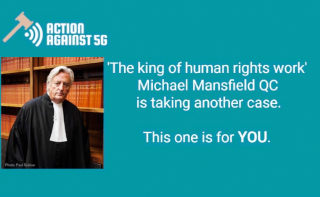Physical Address
304 North Cardinal St.
Dorchester Center, MA 02124
Physical Address
304 North Cardinal St.
Dorchester Center, MA 02124

The anti-5G pressure group Action Against 5G has failed in its attempt to force the Government to warn people about alleged dangers of 5G.
The Government’s defence that 5G is fundamentally the same as 4G, was accepted by Judge Mary Stacey.
Following a hearing at the High courts administrative court she last week ruled:
“The suggestion that the government is under a positive obligation to signpost to the public research or reports that it does not find credible would be confusing and unhelpful at best and dangerous at worst
“If the claimants were right, the government would be required to alert readers of the relevant pages of GOV.UK to “reports” or “research” or doctors of some sort or another who have written opinions that link 5G to coronavirus which the government does not believe to be valid or reliable. It would amount to requiring the government to publicise theories it believes are dangerous and wrong.
“It is uncontroversial that clear and accurate public information and guidance is extremely and increasingly important to counter inaccurate rumours, disinformation and unfounded conspiracy theories which are so easily spread on social media.
“The GOV.UK website provides clear advice and consistent messaging based on its considered opinion which is in line with the international consensus.
“The government has adopted a precautionary approach in its messaging. Although it believes 5G is safe, out of an abundance of caution and on conservative principles it has suggested that those who are worried could, for example unplug the router at night, or not sleep with their mobile phone by their bed and to use their device further away from their body.
The Action Against 5G legal team was led by top human rights lawyer Michael Mansfield KC.

The Group, which had raised nearly £200,000 to press its case, maintains the claim that ‘5G is safe’ is “blatantly at best a misleading oversimplification even when argued from the extremely narrow grounds we were granted when our peer-reviewed science and expert reports confirming biological and health effects remain in the wings.has told itus supporters”
In its reaction to the judgment it said
“This judgment reveals that the Government has now adopted a position whereupon it will decide what will be classified as ‘disinformation’, and in this case by implication, it has ascribed peer-reviewed scientific evidence ‘disinformation’.
“We were not permitted to challenge ‘contested scientific matters’, which amounted to a plethora of peer-reviewed science we presented that remained unexamined and unacknowledged.
“We were not able to challenge the Government’s interpretation of scientific evidence. We were not permitted to argue that the Government had failed to review scientific evidence.
“We were not permitted to argue that the Government had failed to undertake a proper assessment of 5G risks. Overall, we were not permitted to question the Government’s approach to regulation of 5G and we were not permitted to challenge the Government’s adoption of the ICNIRP guideline.
“Our argument was that the Government was not entitled to tell the public there was no risk from 5G namely that it was safe. Adopting a ‘guideline’ which describes ‘expectations of safety’, whose authors confess their guideline is based on incomplete research of multiple possible health outcomes does not translate to ‘5G is safe’.
“The description ‘5G is safe’ even without the qualification ‘within the guideline’ was never employed in the ICNIRP’s literature upon which the Government claimed it had based its advice to the public.
“The fact is that 5G has not been scientifically tested for safety in real life exposure conditions. Denying the evidence does not refute it or make it go away.
Read the full judgment HERE